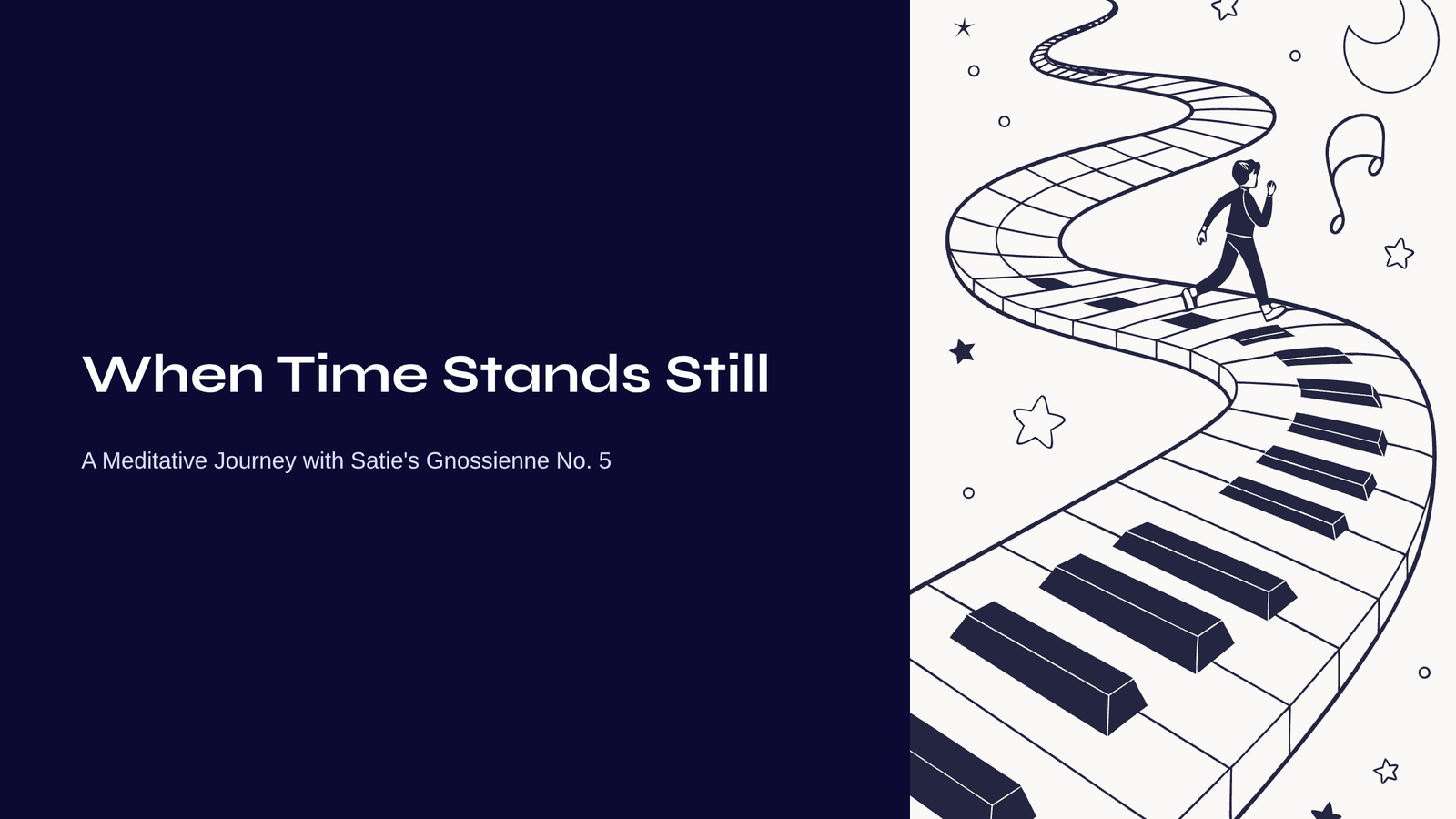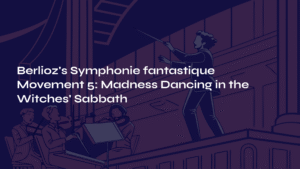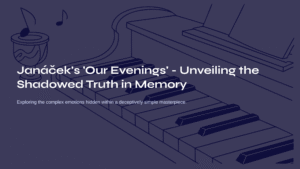Table of Contents
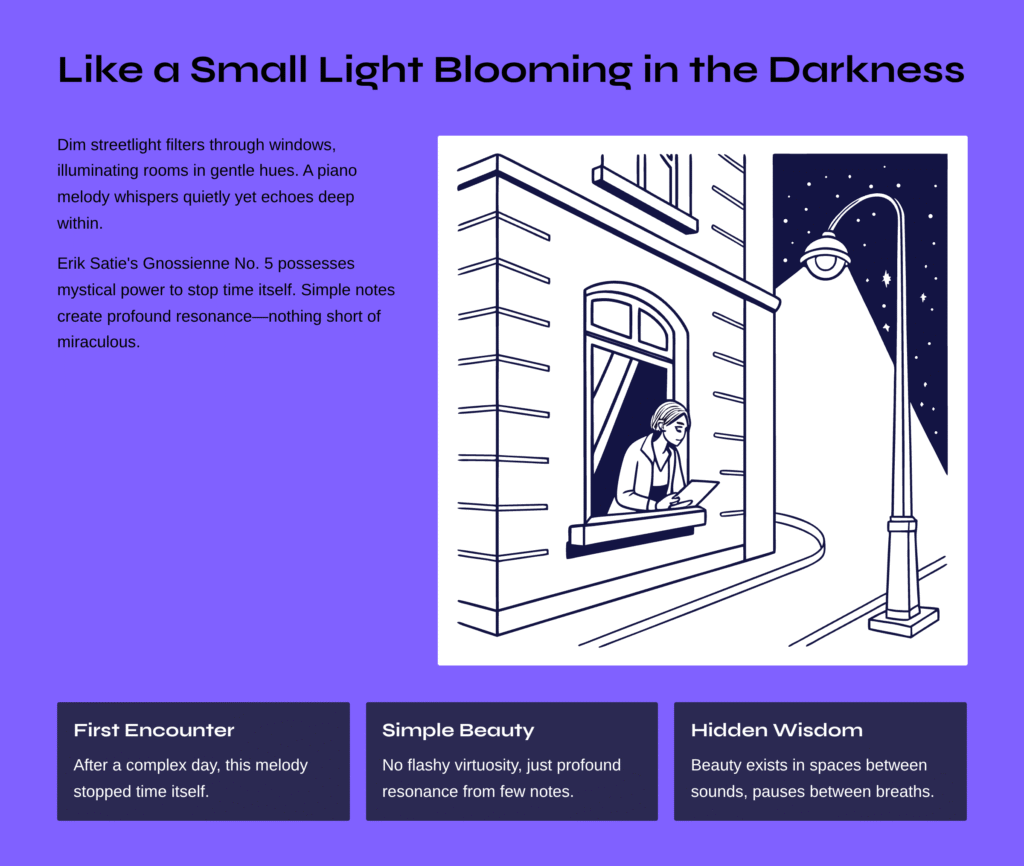
Like a Small Light Blooming in the Darkness
There are nights when the dim streetlight filtering through my window softly illuminates the room in gentle hues. In such moments, a particular piano melody always comes to mind. It’s music that seems to whisper quietly, yet simultaneously echoes from somewhere deep within—Erik Satie’s Gnossienne No. 5.
I remember the first time I encountered this piece. After a complex day, with a weary heart, I stumbled upon this melody that possessed an almost mystical power to stop time itself. Without flashy virtuosity or dramatic development, just a few simple notes could create such profound resonance—it was nothing short of miraculous.
This music taught me that sometimes the most beautiful things in life are also the most understated, existing in the spaces between sounds, in the pauses between breaths.
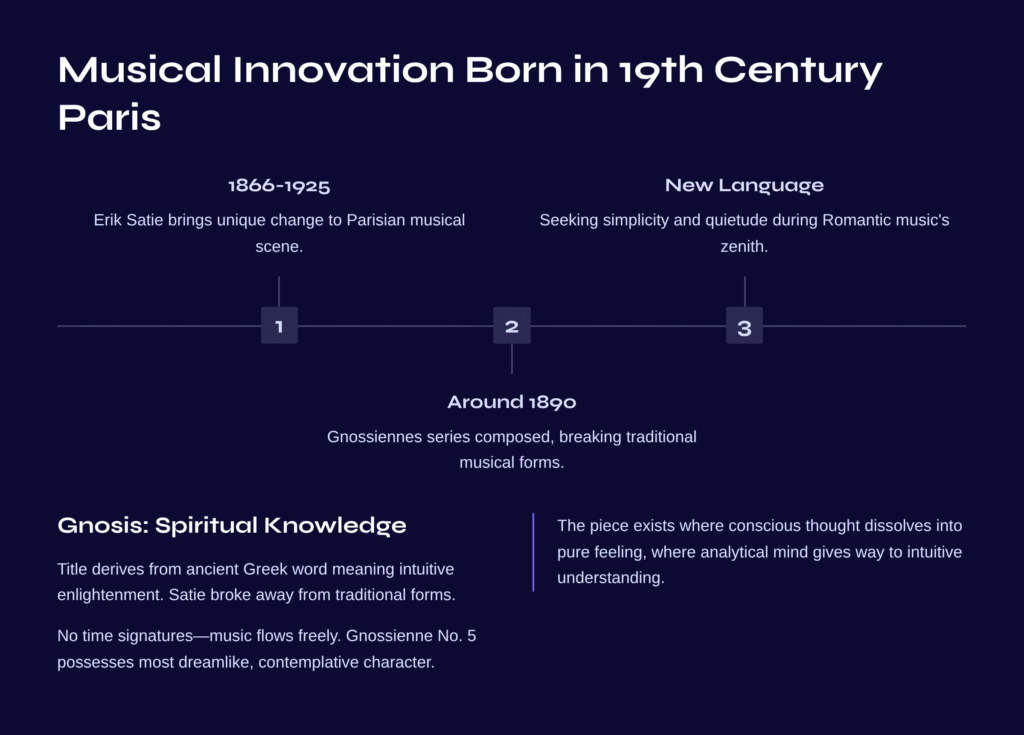
Musical Innovation Born in 19th Century Paris
Erik Satie (1866-1925) was a French composer who brought a unique wind of change to the Parisian musical scene at the turn of the 20th century. During an era when Romantic music was reaching its zenith, Satie chose instead to seek a new musical language within simplicity and quietude.
The Gnossiennes series, composed around 1890, consists of piano miniatures whose title derives from the ancient Greek word “Gnosis,” meaning “spiritual knowledge” or “intuitive enlightenment.” Through this series, Satie broke away from traditional musical forms, allowing the music to flow freely without even including time signatures.
Gnossienne No. 5, in particular, possesses the most dreamlike and contemplative character within the series. Like a piece that blurs the boundaries between dream and reality, it invites listeners to step away from the noise of daily life and face the silence within themselves.
The piece exists in that liminal space where conscious thought dissolves into pure feeling, where the analytical mind gives way to intuitive understanding.
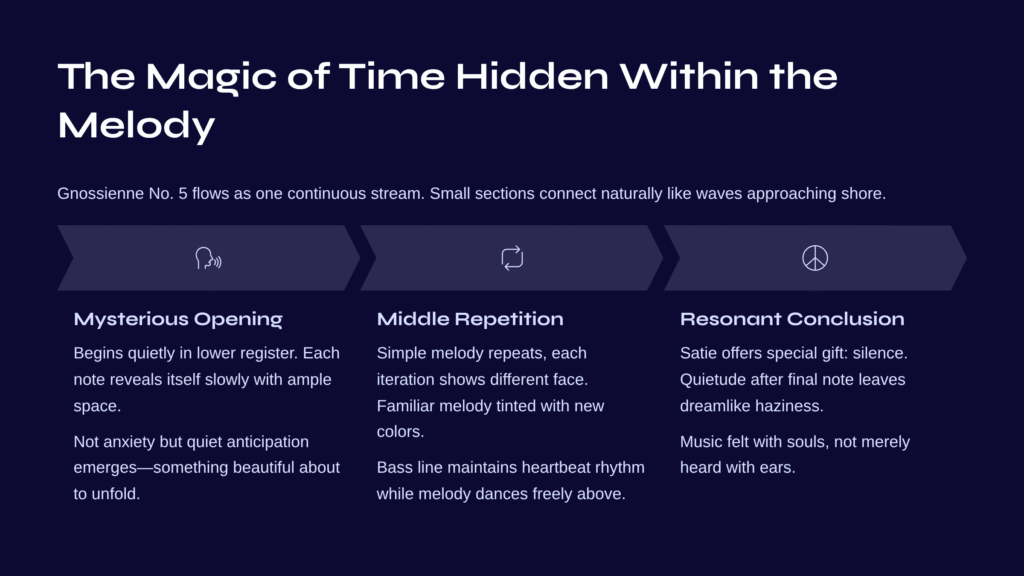
The Magic of Time Hidden Within the Melody
Gnossienne No. 5 flows as one continuous stream without traditional movement divisions. Yet when listened to carefully, you can sense several small sections naturally connecting like waves approaching and receding from the shore.
The Mysterious Whisper of the Opening
The piece begins quietly in the lower register. Like someone carefully stepping through a sleeping house, each note reveals itself slowly with ample space between. What emerges from this section isn’t anxiety but a quiet sense of anticipation—the thrilling feeling that something beautiful is about to unfold.
The Middle Section’s Repetition and Variation
In the heart of the piece, a simple melody repeats several times, yet each iteration shows a slightly different face. Like walking the same path but discovering new scenery each day, the familiar melody becomes tinted with new emotional colors. Here, the left hand’s bass line maintains a steady, heartbeat-like rhythm while the right hand’s melody dances freely above.
The Conclusion’s Resonance and Silence
Near the piece’s end, Satie offers us a special gift: silence. The quietude that remains after the final note has sounded leaves us with a dreamlike haziness, as if we’ve just awakened from a beautiful dream. In this silence, we realize that the music we’ve just heard is not merely something to be heard with our ears, but felt with our souls.
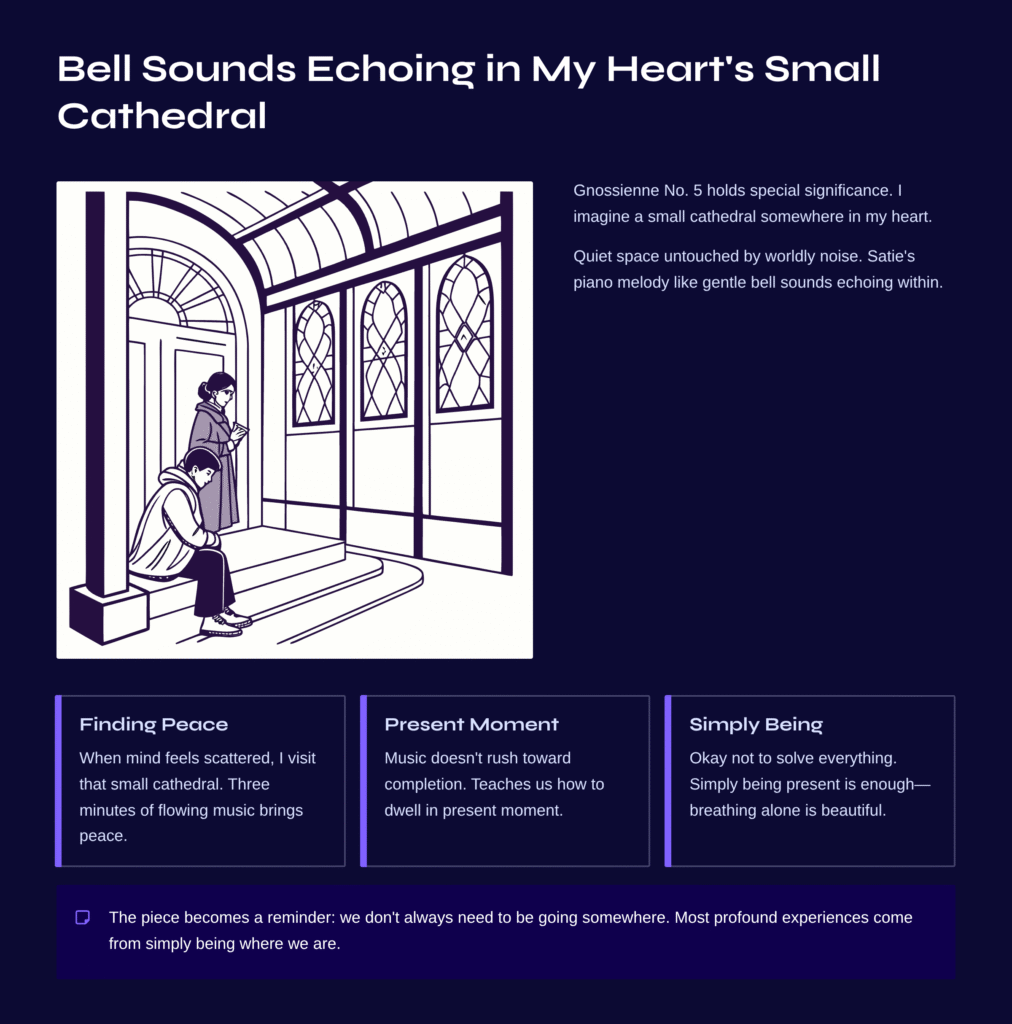
Bell Sounds Echoing in My Heart’s Small Cathedral
For me, Gnossienne No. 5 holds special significance. Every time I listen to this piece, I imagine there’s a small cathedral somewhere in my heart. It’s a quiet space untouched by worldly noise, and Satie’s piano melody is like the gentle bell sounds echoing within that cathedral.
Sometimes, when my mind feels scattered from the complexities of daily life, I listen to this piece and visit that small cathedral. During the three minutes of flowing music, I find peace there. This music tells me it’s okay not to solve everything, not to judge everything—that simply being present is enough.
Particularly when I feel the power of the small rests that appear throughout the piece, I’m reminded that breathing alone is sufficiently beautiful. Satie’s music doesn’t seem to rush toward “completion” but rather teaches us how to dwell in the “present” moment.
The piece becomes a reminder that we don’t always need to be going somewhere—sometimes the most profound experiences come from simply being where we are.

A Small Guide for Deeper Appreciation
First Tip: Don’t Get Caught Up in the Beat
The most important thing when listening to Gnossienne No. 5 is not to try counting beats. Satie intentionally omitted time signatures. Instead, let your body surrender to the music’s natural flow. Like watching clouds drift across the sky, let yourself naturally follow the melody’s current.
Second Tip: Listen to the Spaces of Silence
In this piece, the silences between notes are as important as the notes themselves. Feel the emotions created by the spaces between melodies, the quietude between chords. Sometimes the moments without sound say the most.
Third Tip: Discover the Beauty of Repeated Listening
Though it’s a short piece, I recommend listening to it multiple times. Your feelings on the first listen will differ from your feelings on the fifth. Discovering new nuances in the same melody each time is part of Satie’s musical charm.
Each listening reveals new layers, like looking at a familiar painting and noticing details you’d never seen before.
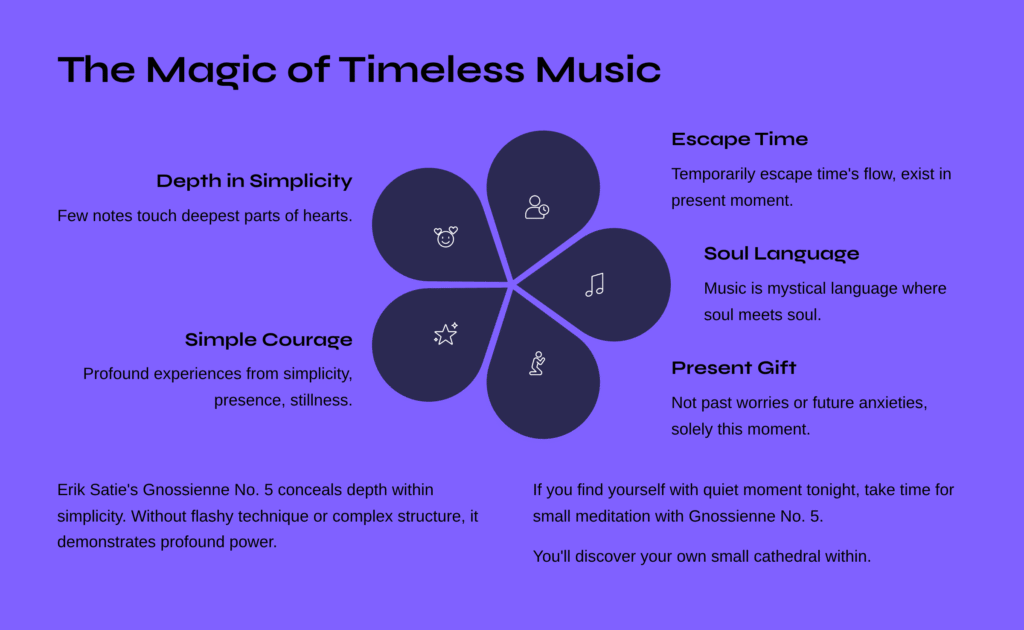
The Magic of Timeless Music
Erik Satie’s Gnossienne No. 5 is music that conceals depth within simplicity. Without flashy technique or complex structure, it demonstrates how just a few notes can touch the deepest parts of our hearts.
While listening to this music, we can temporarily escape the flow of time. We receive the gift of a special time where we can exist not in past worries or future anxieties, but solely in “this present moment.” And in that moment, we come to understand that music is not merely a combination of sounds, but a mystical language where soul meets soul.
The piece reminds us that the most profound experiences often come not from complexity, but from the courage to be simple, to be present, to be still.
If you find yourself with a quiet moment tonight, why not take some time for small meditation with Gnossienne No. 5? I’m certain you’ll discover your own small cathedral within.
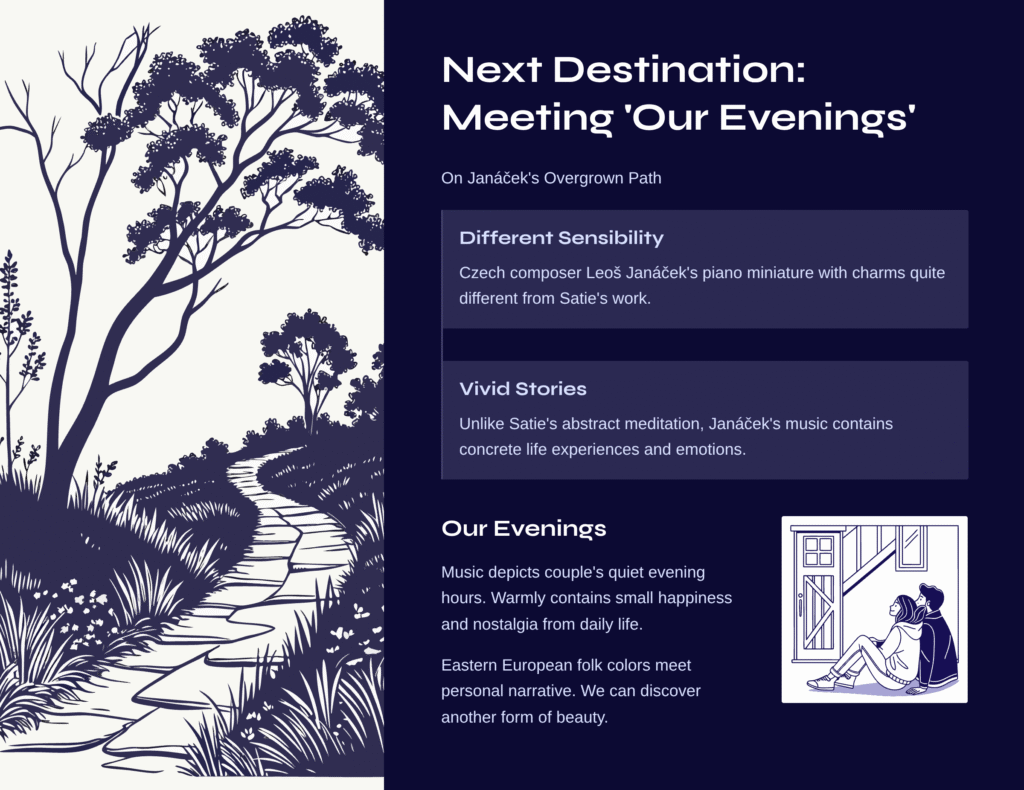
Next Destination: Meeting ‘Our Evenings’ on Janáček’s Overgrown Path
After departing from Satie’s meditative world, shall we embark on a musical journey with a different sensibility? Czech composer Leoš Janáček’s “On an Overgrown Path – Our Evenings” is a piano miniature with charms quite different from Satie’s work.
Unlike Satie’s abstract meditation, Janáček’s music contains vivid stories and emotions from concrete life experiences. “Our Evenings,” as the title suggests, is music that depicts a couple’s quiet evening hours, warmly containing the small happiness and nostalgia found in daily life.
In this piece, where Eastern European folk colors meet personal narrative, we can discover another form of beauty. I look forward to walking together on our next journey.
